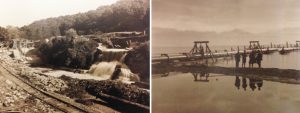Symposium for the opening of the exhibition The Living City: Park Systems from Lausanne to Los Angeles
Monday 29 April 2019, 17:00-20:00
Archizoom, SG building, EPFL
Program:
17:00 – Gallery talk with the curator, Matthew Skjonsberg
18:00 – ‘Hidden Rivers’ symposium, Landscape Habitats initiative, Habitat Research Center
Chaired by Prof. Paola Viganò (EPFL-Director, Habitat Research Center)
Moderated by Matthew Skjonsberg (Curator, The Living City: Park Systems from Lausanne to Los Angeles)
Invited Speakers: Prof. Paola Viganò (EPFL), Prof. Christian Arnsperger (Director, UNIL-Institute for Geography and Sustainability), MER Dr. Elena Cogato Lanza (Lab-U), Dr. Joana Guerrin (UNIL- Faculty of Geosciences and the Environment), Gilles de Diesbach (RTS journalist), Dr. Hannes Markus Peter (ENAC-sber)
19:00 – Vernissage of the exhibition

HIDDEN RIVERS: From Sorge to Chamberonne
Opening the exhibition THE LIVING CITY: Park Systems from Lausanne to Los Angeles, this symposium is the inaugural event of Habitat Research Center’s Landscape Habitats initiative, featuring members of the community – academics and others – who are involved with the well-being of the Sorge and Chamberonne rivers bordering EPFL and UNIL campuses. On Tuesday morning October 10, 2017 the Chamberonne and Mèbre rivers were heavily polluted by a “black and sticky liquid” dumped in large quantities in Chavannes-près-Renens, near the University of Lausanne. As reported by Gilles de Diesbach, a local journalist at RTS, “The alert was given shortly after 10am by a road company that was working nearby…the police arrived quickly to set up a dam of buoys in two places, to avoid the further spread of the thick liquid, black and glutinous, across the surface of the river.” Nevertheless, the pollution spread over a kilometer into Lake Geneva via the Chamberonne – the river into which la Mèbre flows – and, despite the best efforts of nearly 30 local organizations including firefighters, fish guardians and the ‘lake brigade’ who mobilized to control the incident, life in these rivers was severely impacted, water and soil significantly polluted, and plant and animal communities badly impacted.
Among the factors that led to this apparently unprecedented ‘pollution event’ was the fact that these rivers are largely hidden from public view, allowing someone to sidle up near the river with barrels of petroleum waste and illegally deposit this material. Our intention, following UNIL’s exemplary Forêt de Dorigny conservation area, is to bring these sensitive waterways – which harbor some of the region’s most delicate ecological niches, and slopes subject to erosion at the heart of the region’s hydrological system – into the public mind by bringing these hidden rivers to light. To this end, Habitat Research Center initiated this first HIDDEN RIVERS research-by-design project in cooperation with the journalist who broke the story, starting with the causes of the recent disaster and public responses to it, while looking closely at these waterways and their implicit ecological qualities – and finally considering how these can be conserved and further cultivated. The research is organized so as to address pedagogical, practical and policy objectives working together to create design scenarios for ecological coherence, while simultaneously providing enhanced public access, bicycle paths, and space for community interactions: all of which will bring eyes on the river. The basic premise of the research is first-hand ‘nature study’, collectively producing an inventory of social and biological diversity along the riverways – but also within them, revealing microbial life otherwise hidden.
We use the term transdiciplinary to describe this research, because among all such similar terms – such as pluri-, multi-, and inter-disciplinary – it is the only term that explicitly involves those who live there: according to the Swiss Constitution, these biofilm microorganisms are also entities to be considered, as the purpose of the law is ‘to ensure the dignity of living beings’. This involves taking the river and its context as the subject for disciplinary interaction, assessing the ecological, social and economic bases for safeguarding the river, and responding to this with viable design scenarios for the phased implementation of a series of interventions involving the bottom-up interests of those communities along the river – given top-down support from EFPL, UNIL and Canton Vaud.
Matthew Skjonsberg
For more information please see: https://www.epfl.ch/schools/enac/education/design-together-en/enac-week/habiter-lurgence-nouveau/
For questions please contact: [email protected]